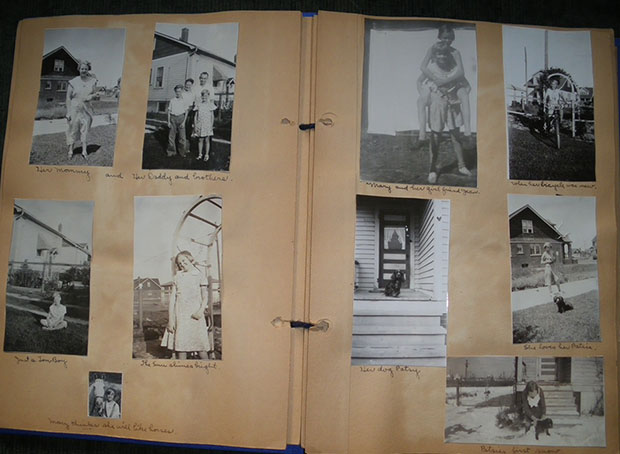Best Way to Preserve Old Letters in a Scrapbook
Preserving Scrapbooks
Winter 2015, Vol. 47, No. 4 | Your Family Archives
By Mary Lynn Ritzenthaler
 (Courtesy of Mary Lynn Ritzenthaler)
(Courtesy of Mary Lynn Ritzenthaler)
Scrapbooks fulfill the desire to acquire, organize, and assemble information about individuals, families, or organizations; significant personal events; or even a subject of interest, such as postcards of all of the state capitals.
The eclectic nature of scrapbooks represent a preservation challenge. Their contents—newspaper clippings, photographs, matchbook covers—are as varied as the design and composition of the books themselves.
Scrapbook pages can be strong and flexible, or they can be weak, brittle, and chip away as they are handled. The adhesives used vary greatly; some can fail over time, resulting in items becoming detached, while others—such as rubber cement or cellophane tape—can cause staining. Some methods of attachment, like photo corners, do a great job of securing items without direct application of adhesive.
The first step in preserving scrapbooks is to determine their condition and any handling limitations. Many scrapbooks used materials that we know today do not meet preservation requirements. Nonetheless, we must accept—and treasure—them for what they are: unique gatherings of material that are best preserved as a unit.
Storage: Do not store scrapbooks in hot attics or damp basements or garages. Damp conditions can encourage the growth of mold and attract insects. Hot conditions can cause paper and adhesives to become brittle. Cool and dry storage conditions are best.
Housing: Store scrapbooks flat to support the binding and to keep detached items from slipping from their pages and becoming bent or lost. Light can cause scrapbook covers to fade. Position bookcases so that sunlight does not fall on items you want to preserve. Preservation-quality boxes sized to fit individual volumes will protect scrapbooks from excess light exposure and keep together pieces of damaged or loose bindings.
Handling: Turn pages carefully to avoid causing tears and breaks. Carefully open folded letters and newspaper clippings, and stop if your efforts seem to be causing damage. Place detached or shifted items back into position, and make sure they have not slipped beyond the edges of the pages. Do not attempt to reattach them. Make sure your hands are clean (avoid lotions that could leave stains), and keep food and drink away from the book.
Making Repairs: Do not attempt to repair scrapbooks you wish to pass on to future generations. Using tape or glue to mend torn pages or to reattach loose or detached items ultimately causes more damage. It is best to simply box a scrapbook, store it flat, and handle the volume very carefully if it must be used. Create a digital copy to provide access and share information while protecting the original.
Making Copies: Do not place scrapbooks face down on a photocopier or scanner. This can place stress on tightly bound volumes and can damage attachments that are folded or not fully secured to pages. Face-up copying is safest, using either a hand-held camera or a face-up copier or scanner. Use book cradles to support volumes at a safe angle of opening to protect the bindings and contents.
If your scrapbook needs repairs or conservation treatment, check the American Institute for Conservation's free referral service to locate a conservator in your region (www.conservation-us.org/membership/find-a-conservator#.).
Find more information on this topic at www.archives.gov/preservation.
Mary Lynn Ritzenthaler is chief of the National Archives Conservation Laboratory.
Articles published in Prologue do not necessarily represent the views of NARA or of any other agency of the United States Government.
Best Way to Preserve Old Letters in a Scrapbook
Source: https://www.archives.gov/publications/prologue/2015/winter/scrapbooks.html
0 Response to "Best Way to Preserve Old Letters in a Scrapbook"
Post a Comment